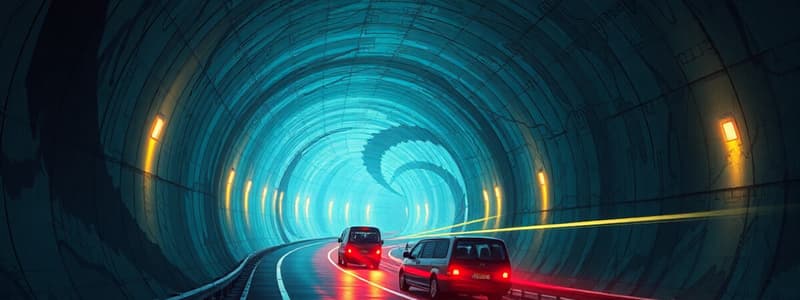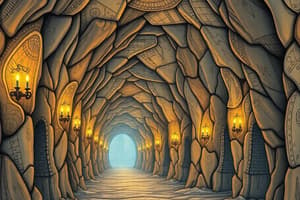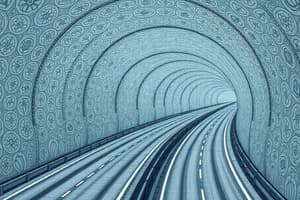Podcast
Questions and Answers
What is a key factor in the site selection process for bridges?
What is a key factor in the site selection process for bridges?
- Type of vehicles that will use the bridge
- Aesthetic appeal of the bridge design
- Availability of construction materials
- Economical span of the bridge (correct)
Which of the following is NOT typically considered when designing tunnel drainage systems?
Which of the following is NOT typically considered when designing tunnel drainage systems?
- Tunnel air quality (correct)
- Tunnel alignment
- Expected water inflow
- Soil permeability
What is the primary purpose of tunnel lining?
What is the primary purpose of tunnel lining?
- To prevent soil erosion at tunnel entrances
- To ensure structural stability and reduce water ingress (correct)
- To facilitate the installation of lighting systems
- To enhance the aesthetic appearance of the tunnel
Which structural form is classified as a type of foundation used in bridge construction?
Which structural form is classified as a type of foundation used in bridge construction?
What does the term 'afflux' refer to in bridge engineering?
What does the term 'afflux' refer to in bridge engineering?
Flashcards are hidden until you start studying
Study Notes
Tunnels
- Necessity of Tunnels: Facilitates transportation through mountains, under waterways or urban areas, offering advantages like:
- Reduced travel time and distance
- Minimizes environmental impact compared to open cuts
- Provides safe passage through difficult terrain
- Types of Tunnels:
- Road Tunnels: Designed for vehicular traffic, accommodating various vehicle types.
- Rail Tunnels: Constructed for railway lines, often featuring longer spans to accommodate trains.
- Pedestrian Tunnels: Primarily for foot traffic, often found in urban areas to connect walkways and streets.
- Water Tunnels: Used to convey water, often through pipelines, for purposes like irrigation, water supply, and hydropower.
- Tunnel Alignment: Determines the route of the tunnel, influenced by factors like:
- Geology: Optimizing alignment to navigate geological formations.
- Topography: Minimizing excavation and minimizing surface disturbances.
- Environmental considerations: Avoiding sensitive ecosystems.
- Size and Shape of Tunnels: Influenced by:
- Traffic volume: Wide tunnels for high traffic, narrower for low traffic.
- Vehicle type: Dimensions dictated by the largest vehicle expected.
- Ventilation requirements: Large cross-sections facilitate air circulation.
- Tunnel Lining: Critical for structural support and stability:
- Concreting: Provides durability and strength, often utilized for urban tunnels.
- Shotcrete: Used for fast construction and stabilization in challenging geological conditions.
- Brick: Cost-effective solution, suitable for smaller tunnels.
- Steel: Provides exceptional strength and durability, often used for larger tunnels.
- Tunnel Drainage: Prevents water accumulation, ensuring safe and efficient operation.
- Tunnel Ventilation: Essential for maintaining air quality and safety:
- Natural Ventilation: Utilizes wind currents for airflow.
- Mechanical Ventilation: Employs fans to push or pull air through the tunnel.
- Tunnel Lighting: Provides visibility and safety for users:
- Incandescent Lighting: Traditional lighting technology, cost-effective but less energy efficient.
- LED Lighting: Energy-efficient and long-lasting, preferred for modern tunnels.
Bridge Engineering
- Components of Bridges:
- Deck: Supports the traffic load and carries the weight of the bridge structure.
- Superstructure: Includes the deck and supporting beams, trusses, or arches.
- Substructure: Supports the superstructure, comprising piers, abutments, and foundations.
- Classification of Bridges:
- Based on Materials: Steel, concrete, timber, or composite materials.
- Based on Structural Form: Beam, truss, arch, cable-stayed, suspension, or cantilever.
- Data Collection: Essential for informed bridge design:
- Topographic surveys: Topography, elevation, and terrain information.
- Geotechnical investigations: Soil conditions and rock properties.
- Traffic studies: Vehicle volume, speed, and weight.
- Site Selection: Influenced by:
- Topography: Suitable terrain for supporting the bridge structure.
- Accessibility: Ease of construction and access for maintenance.
- Environmental constraints: Minimizing impact on natural habitats.
- Economic Span: The optimal span length that balances construction costs and long-term maintenance.
- Estimation of Flood Discharge: Essential for determining the waterway and scour depth.
- Waterway: Minimum width of the channel required to accommodate flood flows.
- Scour Depth: Maximum depth of erosion caused by flood flows.
- Depth of Foundation: Depth required to sufficiently support the bridge structure.
- Afflux: Rise in water level due to the presence of the bridge structure.
- Clearance: Vertical space required for traffic flow.
- Freeboard: Vertical distance between the highest anticipated water level and the bottom of the bridge deck.
- Culverts: Small bridges designed to convey water under roads or railways.
- Types of Foundations:
- Spread Footings: Distribute the load over a wider area.
- Pile Foundations: Transfer the load to deeper soil layers.
- Caissons: Used for deep foundations, provide a watertight enclosure.
- Abutments: Supports located at the ends of the bridge, anchoring the structure.
- Piers: Columns supporting the bridge deck, extending up from the foundation.
- Wing Walls: Extend from the abutments to direct water flow and prevent erosion.
Studying That Suits You
Use AI to generate personalized quizzes and flashcards to suit your learning preferences.




